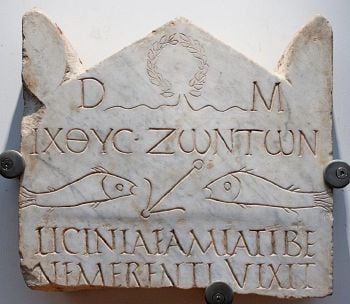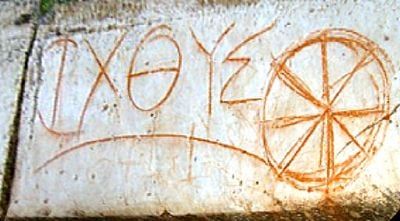Ichthys

Ichthys (Greek: ἰχθύς, capitalized ΙΧΘΥΣ; also transliterated and Latinized as icthus, ichthus or ikhthus), is the Ancient and Classical Greek word for "fish." In English, it refers to a symbol consisting of two intersecting arcs, the ends of the right side extending beyond the meeting point so as to resemble the profile of a fish, said to have been used by early Christians as a secret symbol[1] and now known colloquially as the "sign of the fish" or the "Jesus fish."[2] Several biblical passages associate Jesus with fish or fishing. For example, Jesus called his disciples "fishers of men" (e.g., Mark 1:17) and he miraculously fed 5,000 people with fish and bread (Matthew 14:15-21, Mark 6:30-44, Luke 9:12-17, and John 6:4-13).
Within astrology, the symbol of the fish has the meaning of the sign of Pisces. According to some astrologists, Jesus Christ represents the central figure of the Age of Pisces, which is now giving way to the Age of Aquarius. The Ages go backwards through the signs of the Zodiac. Prior to the birth of Christ, there was the Age of Aries and before that Taurus. Each Age lasts approximately 2,000 years.
History
Ichthus as a Christian symbol
Symbolic meaning
The use of the Ichthys symbol by early Christians appears to date from the end of the first century C.E. Ichthus (ΙΧΘΥΣ, Greek for fish) is an acronym, a word formed from the first letters of several words. It stands for "Jesus Christ God's Son Saviour," in ancient Greek "Ἰησοῦς Χριστός, Θεοῦ Υἱός, Σωτήρ."
- Iota is the first letter of Iesous (Ἰησοῦς), Greek for Jesus.
- Chi is the first letter of Christos (Χριστóς), Greek for "anointed."
- Theta is the first letter of Theou (Θεοῦ), that means "of God," genitive case of Θεóς "God."
- Upsilon is the first letter of Huios (Υἱός), Greek for Son.
- Sigma is the first letter of Soter (Σωτήρ), Greek for Saviour.
Historically, twentieth century use of the ichthys motif is an adaptation based on an Early Christian symbol which included a small cross for the eye or the Greek letters "ΙΧΘΥΣ." An ancient adaptation of ichthus is a wheel which contains the letters ΙΧΘΥΣ superimposed such that the result resembles an eight-spoked wheel.
Fish in the Gospels
Fish are mentioned and given symbolic meaning several times in the Gospels:
First, several of Jesus' twelve disciples were fishermen. He commissions them with the words "I will make you fishers of men."
Second, at the feeding of the five thousand, a boy is brought to Jesus with "five small loaves and two fishes." The question is asked, "But what are they, among so many?" Jesus multiplies the loaves and fish to feed the multitude.
Third, in Matthew 13:47-50, Jesus compares God's decision on who will go to heaven or to hell ("the fiery furnace") at the end of this world to fishers sorting out their catch, keeping the good fish and throwing the bad fish away.
Fourth, in John 21:11, it is related that the disciples fished all night but caught nothing. Jesus instructed them to cast the nets on the other side of the boat, and they drew in 153 fish. It has been observed that, like many other numbers given in the Bible, this number is associated with a mystic property, in this case the vertical ratio of the shape known as the vesica piscis.[3]
Finally, a less commonly cited use of fish may be found in the words of Matthew 17:24-27, in which, upon being asked if his Teacher does not pay the temple (two-drachma) tax, Simon Peter answers, "Yes." Christ tells Peter to go to the water and cast a line. He says that a coin sufficient for the tax will be found in the fish's mouth. Peter does as told, and does find the coin.
The early Christian church
Societies of Christians in Hellenistic Greece and Roman Greece, prior to the Edict of Milan, protected their congregations by keeping their meetings secret. In order to point the way to ever-changing meeting places, they developed a symbol which adherents would readily recognize, and which they could scratch on rocks, walls and the like, in advance of a meeting. At the time, a similar symbol was used by Greeks to mark the location of a funeral, so using the ichthys also gave an apparent legitimate reason for Christians to gather. Christians, when threatened by Romans in the first centuries after Christ, used the fish symbol to mark meeting places and tombs, or to distinguish friends from foes. The publication cites one ancient explanation, still popular today:
When a Christian met a stranger in the road, the Christian sometimes drew one arc of the simple fish outline in the dirt. If the stranger drew the other arc, both believers knew they were in good company. Current bumper-sticker and business-card uses of the fish hearken back to this practice. The symbol is still used today to show that the bearer is a practicing Christian.[4]

Some sources indicate that the earliest literary references came from the recommendation of Clement of Alexandria to his readers to engrave their seals with the dove or fish (Paedagogus, III, xi). However, it can be inferred from Roman monumental sources such as the Capella Greca and the Sacrament Chapels of the catacomb of St. Callistus that the fish symbol was known to Christians much earlier. This Christian symbol might well have been intended to oppose or protest the pagan apotheosis of the Roman emperor during the reign of Domitian (81 - 96 C.E.). Coins found in Alexandria referred to him as Theou Huios (Son of God). In fact, even earlier, since the death and deification of Julius Caesar, Augustus (Octavian) already styled himself as divi filius, son of the divine (Julius), and struck coins to that effect. This practice was also carried on by some of the later emperors. Another probable explanation is that it is a reference to the scripture in which Jesus miraculously feeds 5,000 people with fish and bread (Matthew 14:15-21, Mark 6:30-44, Luke 9:12-17, and John 6:4-13). The ichthys may also relate to Jesus or his disciples as "fishers of men" (e.g., Mark 1:17).
Other theories about the Historicity of Jesus suggest that Christianity adopted certain beliefs and practices as a syncretism of certain mystery religions such as Mithraism, and that this may be the origin of the ichthys in Christian circles. For example, Barbara Walker hypothesizes in her book, The Woman's Dictionary of Symbols and Sacred Objects, that the Ichthys was the son of the pagan sea goddess Atargatis. She also posits that the Ichthys symbol was a representation of sexuality and fertility.[5]
Ichthys in popular culture
The "Jesus Fish" has become an icon of modern Christianity. Today, it can be seen as a decal or emblem on the rear of automobiles or as pendants or necklaces as a sign to the world that the owner is a Christian. It is incorporated into business logos or in business advertisements and listings in telephone books. It is also seen on clothing. Versions of this include an Ichthys with "Jesus" or "ΙΧΘΥΣ" in the center, or simply the Ichthys outline by itself. This badge may also be seen in e-mail signatures with the symbols "<><."
Parodies of the ichthys symbol
Distortions of the Ichthus symbol in popular culture rely on its use as a symbol of Christianity.:
- The Darwin Fish, which often appears as a bumper sticker, is a satirical representation of the symbol, reversed and with feet attached and often with the name "DARWIN" in the middle. It is a depiction of an early tetrapod like ichthyostega. The image implies acknowledgment of Charles Darwin's theory of evolution in contrast to biblical creation (creationism). There are also variations, like the Truth fish (an ichthys eating the Darwin fish), or a Darwin fish eating the ichthys.
- An ichthys-style symbol representing Cthulhu, the fictional amoral deity monster from the 1928 short story "The Call of Cthulhu" by H. P. Lovecraft.
- A stylized symbol for the "Flying Spaghetti Monster," the deity of a parody religion called The Church of the Flying Spaghetti Monster and its system of beliefs, "Pastafarianism."
- In the episode, "Robotology" of Futurama, Bender, asks if he can put a version of his religion's ichthys symbol on the tail end of the Planet Express Ship.
Notes
- ↑ Robert D. Luginbill, Explanation of the Ichthys Symbol and Acronym Ichthys. Retrieved March 20, 2023.
- ↑ Jonah Goldberg, Evolution of religious bigotry Los Angeles Times, April 1, 2008. Retrieved March 20, 2023.
- ↑ The Age of Pisces, the Fish Vesica Piscis. Retrieved March 20, 2023.
- ↑ Elesha Coffman, What is the origin of the Christian fish symbol? Christianity Today. Retrieved March 20, 2023.
- ↑ Barbara G. Walker, The Woman's Dictionary of Symbols and Sacred Objects (HarperOne, 1988, ISBN 978-0062509239).
ReferencesISBN links support NWE through referral fees
- Ferguson, George. Signs and Symbols in Christian Art: With Illustrations from Paintings from the Renaissance. Oxford University Press, 1966. ISBN 978-0195014327
- Inman, Thomas. Ancient Pagan And Modern Christian Symbolism. Inman Press, 2007. ISBN 978-1406751833
- Sill, Gertrude Grace. A Handbook of Symbols in Christian Art. Touchstone, 1996. ISBN 978-0684826837
- Steffler, Alva William. Symbols of the Christian Faith. Wm. B. Eerdmans Publishing Company, 2002. ISBN 978-0802846761
- Walker, Barbara G. The Woman's Dictionary of Symbols and Sacred Objects. HarperOne, 1988. ISBN 978-0062509239
Credits
New World Encyclopedia writers and editors rewrote and completed the Wikipedia article in accordance with New World Encyclopedia standards. This article abides by terms of the Creative Commons CC-by-sa 3.0 License (CC-by-sa), which may be used and disseminated with proper attribution. Credit is due under the terms of this license that can reference both the New World Encyclopedia contributors and the selfless volunteer contributors of the Wikimedia Foundation. To cite this article click here for a list of acceptable citing formats.The history of earlier contributions by wikipedians is accessible to researchers here:
The history of this article since it was imported to New World Encyclopedia:
Note: Some restrictions may apply to use of individual images which are separately licensed.



